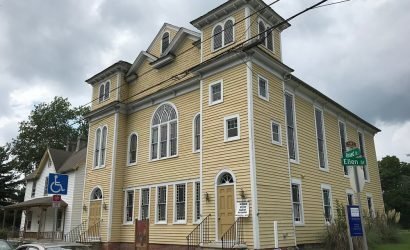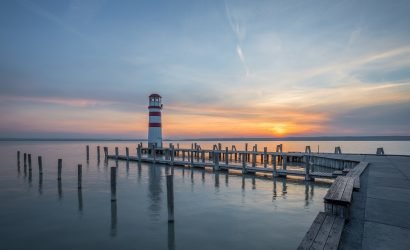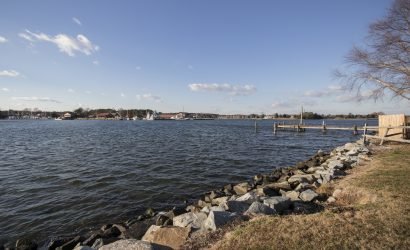We recently visited the Western Shore of Maryland for a family birthday party and decided to take the opportunity to go Day Trippin’ to St. Mary’s County. This peninsula of land juts into the Chesapeake Bay and is filled with rich history and an eclectic mix of tourist attractions. To be honest, we were a little overwhelmed, so we quickly decided to go with an old favorite, heading for the closest of many lighthouses in the area.
Our first stop was the Piney Point Lighthouse, which features a white two story conical structure as well as a museum. The building is located at the confluence of the Potomac and Chesapeake with a white light that can be seen up to 15 miles away. The lighthouse got its name from the loblolly pines that grow in the area.
The lighthouse was built in 1836 by John Donahoo, the architect behind many other Maryland lighthouses. The design that Donahoo used to create the thick conical structure was cheap and sturdy, which appealed to the auditor of the treasury at the time. As a result, Donahoo’s designs became popular and prevalent within the area.
The grounds of the lighthouse were purchased, after some deliberation, from Henry and Charlotte Suter in 1835. Henry Suter finally agreed to relinquish the land only on the condition that he could be the keeper, however he passed away before completion. His wife later served as the third keeper for seven months until she was dismissed for heavy drinking.
The lighthouse became automated and unmanned in 1964 and was used by the Coast Guard for housing until 1980. It was then given to St. Mary’s County before the St. Clements Island-Potomac River Museum took possession of the area. The grounds were refurbished and reopened to the public in 2002 with the help of the Steuart Petroleum Company. It is no longer used as a navigational tool but is sometimes still lit.
Piney Point also has a notable spot in history dealing with German U-boats during WWII. After the war, the U.S. was given a U-1105 German submarine that was coated in synthetic black rubber to help evade the Allied forces. After the U.S. finished running tests on the sub, it was sunk off the coast of Piney Point where it was first used for torpedo before becoming Maryland’s first historic shipwreck dive preserve.
The museum located at the Piney Point Lighthouse covers the history of this German sub as well as watermen history and the presidential legacy associated with the area. The town was formerly a socialite getaway for many statesman including James Monroe, Franklin Pierce, Theodore Roosevelt, statesman Daniel Webster, and Vice President John C. Calhoun.
The museum also offers a glimpse at maritime history with four historic wooden vessels on loan from the Paul Hall School of Maritime Training and Education. Visitors can take a peek into the past by seeing a 67-foot skipjack (Joy Parks), an 84-foot bugeye (Dorothy A. Parsons), a log canoe and a Potomac River dory boat. Bring your own boat and sail up to the lighthouse and its picnic areas or bring along your kayak to launch at the site.
Another lighthouse that we couldn’t visit due to our own lack of aquatic transportation is Point no Point. This lighthouse sits 2 miles out from shore in the Bay, near the mouth of the Potomac. It was first created due to the need for a light between Cove Point and Smith Point in 1891.
During construction in 1903, a temporary pier was built and attached to part of the lighthouse called the caisson. Unfortunately the pier broke off from the structure and carried the caisson with it out into the water. Part of the building overturned and drifted down bay, floating forty miles away until it was later picked up by the Rappahannock River. After the caisson was retrieved and repaired, it was quickly secured to its permanent foundation.
In 1904 another pier broke away, after being damaged by ice, this time taking different parts of the building such as the air compressor, boiler and workmen’s quarters into the Bay. After these setbacks, the lighthouse was finally completed in 1905. It had a light that flashed red and white at 20 second intervals and a mechanical bell sounded every 15 seconds during foggy or bad weather.
As the year’s passed, the light became automated in1938 but still had keepers such as the Coast Guard until 1962. Unfortunately, years of disrepair caused the building to become dilapidated and caused the lighthouse to be refurbished in 1988, 1989 and 2001.
The next stop on our tour was a particularly spooky spot. Point Lookout Lighthouse is not only located at the confluence of the Chesapeake and the Potomac but it is also a confluence of many different paranormal sightings. In fact, some consider to be the most haunted place in America and we can tell you, just by looking at it we got the chills.
In 1825 the federal government recognized the need for a lighthouse at the spot where the Potomac River meets the Chesapeake Bay to warn ships of the shoals in the area and mark the entrance of the Potomac. Donahoo was once again called on to build the lighthouse, although this building differs greatly from Piney Point’s design. The land for the structure was purchased from Jenifer Taylor and his wife, who are buried in the picnic grounds of the lighthouse.
The long string of keepers who died in the lighthouse or lead mysterious lives also adds to the strange ambiance of the building. The first lighthouse keeper was James Davis, who died a few months into his service, lived with two slaves and his daughter, Ann Davis. Ann continued to be a keeper after her father passed away, also selling alcohol out of the lighthouse to sailors who passed by the point. She died in 1847 – also while living in the lighthouse.
Richard Edwards became a keeper after Davis but died in 1853. Like the Davis family, his daughter Pamela took over after his term of service. Pamela inhabited the point during the Civil War and is rumored to have held prisoners in the lighthouse. She also hired an assistant keeper who had once been a head nurse in the Union army but had been known as a rebel sympathizer.
The Hammond General Hospital was also built near the Point in 1862 and a prison camp for Confederates was built after the Battle of Gettysburg. The camp had terrible conditions with over 20,000 prisoners living within, resulting in the death of 4,000 men. With these two sites being so closely located to the lighthouse, it does not surprise us that ghostly occurrences are common.
No paranormal activity was reported in the building until the late 1960s when multiple keepers described mysterious happenings. Many psychics have visited the location and countless séances have been performed inside of the walls to learn about past visitors. Some of the spiritual encounters include possibly hearing the voice of Ann Davis, who simply said “my home.” She has also been seen in a white blouse and blue skirt. One keeper often locked his dog on a screened in porch but would often find the dog out and about with the lock undone.
Another story recounts the ship wreck of a boat that crashed off the coast of Point Lookout. It is said that one of the survivors rowed away from the wreck in search of help, however he never reached the lighthouse. One time a lighthouse guest saw a man on the lighthouse deck, dressed in old clothing and looking as if he needed help. However when the guest opened the door to approach the man, he had vanished.
If there is one thing we learned on our Day Trippin’ adventure to the opposite side of the Chesapeake, it’s that lighthouses have a very colorful history. Maybe next time we’re in the area we will take a trip to the Patuxent River Naval Air Museum to get a different view of our nation’s history.









